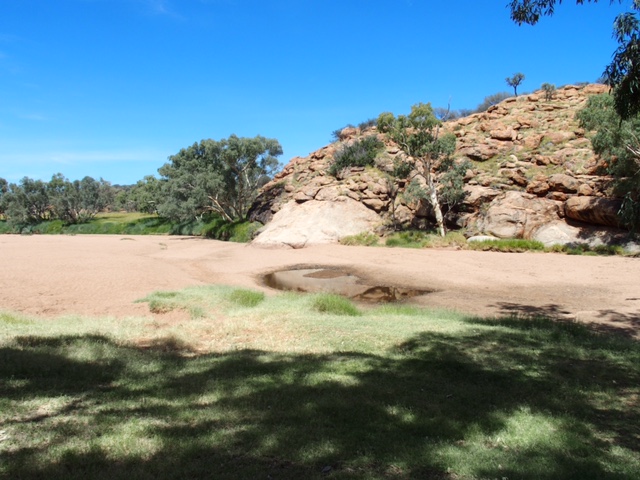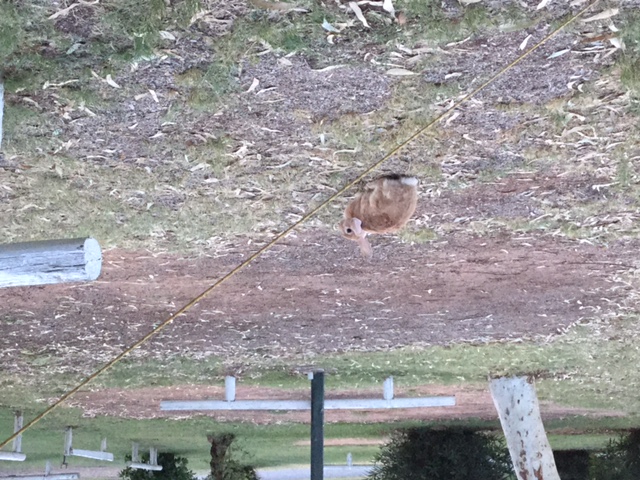In 'A Town named Alice!'

Seaduced
John & Jane Craven
Sun 1 Mar 2015 07:53
We set off from Coober Pedy intending to stop off on the way as there were a few roadhouses dotted along the Stuart Highway, which we were on. However, having see the first two, they were basic and very expensive at about $140 per night for a cabin that might have a fully functioning en-suite if you were lucky - we had booked a room at the 5 star Lasseters Hotel in town for the last night before our Uluru tour for less than that! We decided to press on and are glad we did as just as we crossed the state line into the Northern Territories, the clocks went back an hour giving us more than enough time to do the whole drive and still have time to set up the tent when we arrived. That done we now have an extra day to explore. We have a tour booked out to Uluru and Kings Canyon, more on this later, but until then we have Alice to explore.
A bit of history. Alice Spring was initially called Stuart Town after the chap who mapped the route from Adelaide to Darwin in about 1850 or so. At the time the only way to get a message to England, the mother country, and also receive a response was by sea, which took an absolute age and replies when they were received were often outdated and useless. Once the route had been mapped, on the second attempt, it was possible to create the overland telegraph. This meant messages could be sent from Adelaide to Darwin, to India, again by telegraph, and then by using the link already in place due to colonisation, back to England, making the whole process much quicker and more efficient. There was a telegraph station at the then named Stuart Town, but little else. A few years later a chap called Charles Todd happened by, and seeing the fresh water in the river, assumed that there was a spring nearby, and that it would be possible to settle a town here. He named the town after his wife - no prizes for guessing her name! As it happened, there was no spring at all, and no water, so the town was about to fail when they consulted the local Aborigines who explained that Alice is a town of upside down rivers, the water flows constantly but about 1-5 meters underground. The only time that there is any water in the creek or river beds is when there are huge floods! Having found water, the settlement continued and now there is a thriving town, right in the middle of nowhere! Oh, also, Alice never actually lived in or even visited the town.
The famous Alice Spring, right in the heart of the mighty Todd River, you have to use your imagination for that one!
So what is there to do here? Alice is surprisingly the centre of outback life and home to a lot of important things which make life here and in the more remote areas possible. The first thing to be started here was the Royal Flying Doctor Service. Started as a means of getting medical help to the remote communities and cattle stations, it has now become an essential service for most of Australia, providing medical care and transport the country over. They provide and supply medical kits for stations etc and full back up when you need to use it.
Also, the other major service based in Alice Springs is the School of the Air. This is an amazing organisation providing education in the worlds largest classroom. The area they cover here at Alice is 1.3 million square kilometres! There are currently 122 children aged between 5 and 15 who are educated this way. At the outset, it was all done by radio, but now with advances in technology, all the broadcasts are done via the Internet. Each child who is enrolled is given everything they need to 'attend' lessons, including a satellite dish, computer, web cam etc to allow them to get access to the Internet! They are also given all the materials they need to conduct experiments in science and get involved in art projects, some of these kids are a 9 hour drive or more from town, so there is no popping to Woolworths to get glue and colouring pencils!
The kids who attend this school are nothing like the school children we know at home. They work on cattle stations from a very young age, driving trucks, branding cattle, mustering cattle, all before school starts. Some of the stations are so huge, they use helicopters to muster the cattle as it is cheaper than horses and human drovers! It is definitely a different life out there.
This is a map showing where the children who attend the school live.
While we were here we also went to the National Pioneer Women's Museum, and apart from all the achievements, what really is surprising is now recent they all were, most of them are in the last 50 years or less ie the first woman doctor, vicar, architect etc.
This is the first place where we have really come into contact with the indigenous people of Australia, with mixed reactions at the outset. The problem was we had no understanding of the culture and the history, yet having met with an Aboriginal guide at the Desert Centre and doing the Uluru tour we know have a much better understanding of how it all works, and the problems that have resulted from the white folks marching in and taking whatever they wanted.
The Desert Centre was also very interesting with a chance to see dingos, kangaroos, and other indigenous animals. This along with a visit to the Reptile Centre, showed us all the scary stuff that lives here.
A true, full blood dingo
Rock wallabies that we saw at the Spring
Terry the saltie bears his very sharp teeth at the Reptile Centre! He is currently about 7 years old and 3.5m long, he will continue to grow as long as he lives and may even live to be 100 - yikes!
This was the rabbit at the the campsite - a cute furry bunny, or so you might think, he actually chewed through the same tent guy rope twice, so John was 'hopping mad' and out for blood!
Sent from my iPad





